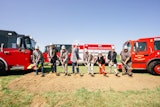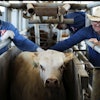
Chem.Info’s recurring Regs Report feature presents new and emerging regulations and enables readers to better achieve compliance. In this installment, we explore the NFPA 2112 standards on flame resistant garments for protection against flash fires.
 For workers in the chemical, petroleum and related industries flash fires, a fire that spreads rapidly through a diffuse fuel, is a concern that requires specific personal protective equipment. In order to provide protection and reduce the severity of burn injuries from flash fires, processors should follow the National Fire Protection Association (NFPA) 2112 standard.
For workers in the chemical, petroleum and related industries flash fires, a fire that spreads rapidly through a diffuse fuel, is a concern that requires specific personal protective equipment. In order to provide protection and reduce the severity of burn injuries from flash fires, processors should follow the National Fire Protection Association (NFPA) 2112 standard.
According to the NFPA, the NFPA 2112 standard “shall specify the minimum performance requirements and test methods for flame-resistant fabrics and components and the design and certification requirements for garments for use in areas at risk from flash fires.” By following these standards, processors will be able to provide their employees garments to protect them from the dangers of flash fires.
When purchasing fire-resistant (FR) garments, processors must note several performance requirements as well as various testing that must be completed to ensure the garments will protect against flash fires. The NFPA also notes that manufacturers must provide users with information including warnings, information and instructions with each FR garment as well as a sizing chart indicating the range of key wearer measurements.
Fabric Performance Requirements
The type of fabrics used for conventional work clothing can pose a danger to workers in a potential flash fire environment. In the article, “Industrial Flash Fire and Burn Injury Fundamentals with an Instrumented Manikin Demonstration of Protective Clothing Performance,” the authors note that conventional work clothing is typically made of 100% cotton, polyester/cotton fiber blends or nylon/cotton fiber blends.
These types of fabrics are generally lighter in weight, ignite at lower exposure energy, and burn with a higher flame spread rate than heavier weight fabrics. The NFPA also notes that “flammable clothing can contribute to the severity of burn injuries through its ignition and continued burning after exposure to flash fire.” As a result, it is crucial for employees working in an area with flash fire risks to wear FR garments that meet the NFPA 2112 standards.
The NFPA requires several tests be conducted on the FR garments including heat transfer performance (HTP). The garments must have a “spaced” HTP rating of not less than 25 J/cm2 and a “contact” HTP rating of not less than 12.6 J/cm2.
Additionally, several tests must be conducted to determine the thermal shrinkage resistance including FR fabrics and cold weather insulation. The FR fabrics must not shrink more than 10 percent in any direction, and the cold weather insulation must not shrink more than 20 percent in any direction.
According the NFPA, interlinings, collar stays, elastics, closures, and hook and pile fasteners that are not in contact with skin are not required to be tested for heat resistance.
To meet the standards, garments must be tested for overall flash fire exposure and exhibit an average predicted body burn of not more than 50 percent based on the total surface area covered by sensors, excluding hands and feet.
The NFPA 2112 standard also notes specific thread and hardware requirements. The requirements of all sewing thread must be made of flame-resistant fiber, be tested for heat resistance and can not melt. Hardware, including buttons, fasteners and closures, must be individually tested for heat resistance in the original form. They must not melt or drip, separate or ignite.
Testing Methods
There are several testing methods the NFPA 2112 requires in order to determine the specific performance of the FR garments. Three testing methods included in the standard are HTP, flame resistance, and heat and thermal resistance testing. Prior to conducting the test, The NFPA requires that the garment must be conditioned at 70 degrees Fahrenheit with a relative humidity of 60 percent for at least 4 hours. Then, the garment must be tested within 5 minutes of being removed from conditioning.
Heat Transfer Performance. According to the NFPA, HTP testing must be conducted on six specimens, consisting of all layers of the garment. Three of the specimens must be tested in spaced configuration and three specimens must be tested in the contact configuration. Also, the specimens will be tested before and after three cycles of washing or dry cleaning, depending upon the garments requirements. To determine the rating of the garment, it will receive a pass or fail separately based on the individual average HTP ratings for both spaced and contact tests.
Flame Resistance. Users should review the NFPA 2112 standard for specific requirements in the testing modifications for woven, knit and non-woven textile materials. Testing specimens are required to measure as a rectangle of 3 inches by 12 inches, and each individual layer of multilayer materials must be tested separately. Included in the 2112 standard is the requirement for all FR specimens to be tested before and after 100 cycles of washing or dry cleaning. To determine the performance of the FR specimens, the NFPA 2112 requires a pass/fail based on any observed melting and dripping, the average after-flame time and the average char length, and if there is failure in either direction it will result in failure of the material.
Heat and Thermal Shrinkage Resistance. When following the NFPA 2112, testing of heat and thermal shrinkage resistance applies to flame-resistant fabrics, components and hardware. The testing must be conducted on a minimum of three specimens with each separable layer of multilayer materials tested as an individual layer. The fabrics also need be tested after three wash or dry cleaning cycles. When conducting the testing for heat and thermal shrinkage resistance, NFPA 2112 requires the test oven to have a “horizontal flow circulating oven with minimum interior dimensions to permit the specimens to be suspended and be not less than 2 inches from any interior oven surface or other test specimens.” The test oven should have an airflow rate of 125 feet/minute to 250 feet/minute at the standard temperature and pressure of 70 degrees Fahrenheit at 1 atm.
By reviewing the NFPA 2112 standard when purchasing fire resistant garments, processors can determine the most effective garments that will provide their employees with protection, as well as reduce the severity of injuries, from flash fires.























